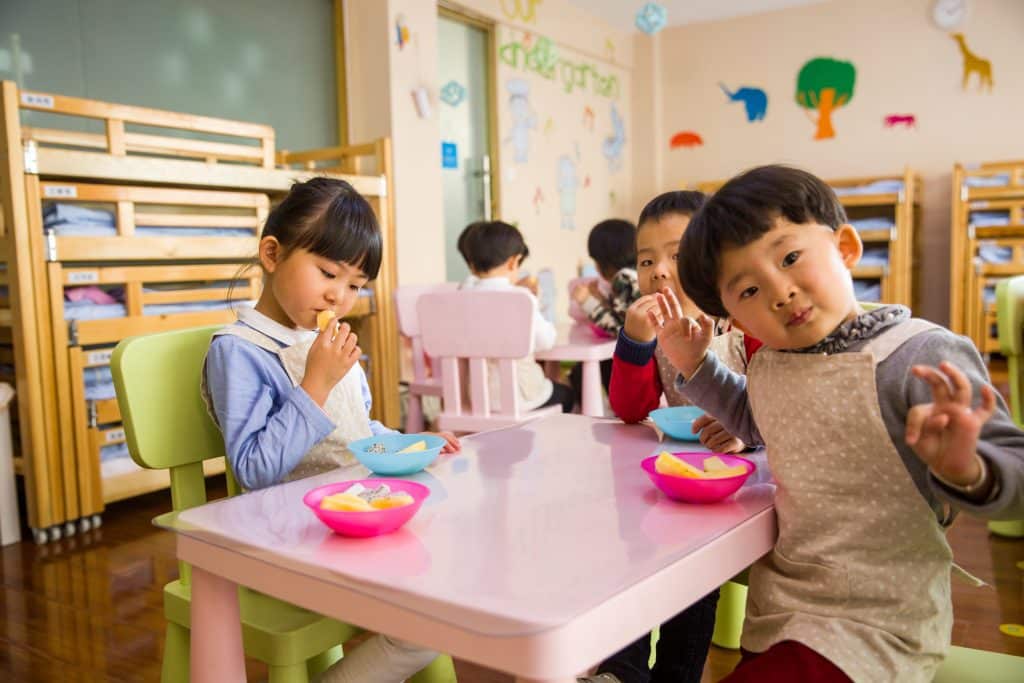
Contents [show]
Disorders of the baby’s feeding or eating behavior
The disorders of the feeding or eating behavior of the baby existed. What are they? How to spot them? What treatments are offered? The answers.
The baby’s eating disorders: what is it?
The terminology itself demonstrate the vagueness inherent in these disorders: food refusal, food phobia, food aversion, anorexia of the infant, small appetite, second-trimester anorexia, etc. It also affects the baby’s growth in the first six months. Apart from pica and merycism, eating disorders of the child and the baby were not defined in the major international classifications. The classification of the American Psychiatric Association had to be in its fourth revision (in 1994) so that the disorders of the eating behavior of the young child are listed as such and differentiated from eating disorders of other ages. life (such as anorexia nervosa and bulimia ).
Read Also: Five food groups – Healthy food for school-age kids
These disorders are defined as the absence of weight gain or a significant weight loss for at least one month. Not due to organic disease or other mental disorder, or a lack of food, with a beginning before the 6 years old.
Note: when the eating disorder is associated with growth retardation, and no somatic etiology is shown the clinical situation is that of nonorganic growth retardation, called dwarfism or psychogenic growth retardation.

Post-traumatic eating disorder
The food refusal occurs after a traumatic event or as a result of several chronic or repetitive trauma on the oropharynx or esophagus.
It can be an accident of:
- wrong road with a solid,
- trauma by attempting to force-feed,
- the medical original trauma (nasogastric tube, enteral nutrition, intubation, suction, etc …).
What are the signs of post-traumatic eating disorder?
In the infant, the refusal of food can be selective: refusal of the bottle after an incident of vomiting or false bottle-feeding but the child agrees to feed himself with a spoon. On the contrary, he refuses to eat solid food after strangling himself with a portion of solid food but accepts the bottle. In severe cases, the child refuses any food.
During the traumatic event, the child shows great distress in the activities that remind the traumatic event, such as the preparation of the meal, the setting of the towel. The child also has signs of anticipatory anxiety.
WHAT ARE THE RISKS FOR BABY?
The nutritional status of the child is variable according to the intensity of the food refusal, the duration of the disorder, the adequacy and the adaptation of the nutritional substitutions.
Long-term complications may occur in the case of prolonged refusal of food :
- delayed oro-motor development,
- difficulty learning chewing and swallowing,
- delayed language development.
Treatment for Post-traumatic eating disorder
In post-traumatic stress disorder, the treatment is essentially based on behavioral psychotherapy techniques with anxiety work and a progressive relearning of the child’s diet.
The program is established with all stakeholders, and with very progressive levels of programming. Reintroduction of food with positive reinforcements and is established so that there is no failure and no return.
Trouble disorder type of attachment disorder
What are the signs of trouble disorder type of attachment disorder?
It appears between 2 and 8 months, so very early.
Not only does the child show signs of malnutrition but there is also a repercussion on socio-emotional, cognitive and motor development (retarded intellectual development, apathy, withdrawal, even depression picture with slowing down, rigid mimicry, lack of initiatives and lack of interaction in the game).
During meals, more than a conflict, one notices poverty of the exchanges even a total absence of reciprocity.
Often, the mother may suffer from significant psychopathological disorders that cause a lack of care (such as schizophrenia, alcoholism, drug addiction, or depression ). The most serious forms of attachment disorders have been described in situations of maltreatment and social contexts of great precariousness and poverty.
It is therefore particularly important to identify the mother’s mental disorder to treat it. This approach can be particularly effective in the case of depressions which are the most accessible disorders to suitable treatment.
WHAT RISKS FOR BABY?
Incompetent intake both nutritional level that emotionally affects:
- the child development
- emphasize his behavioral disturbances, reinforcing the distortion of the mother-child relationship.
Treatment for trouble disorder type of attachment disorder
In the attachment disorder, the intervention of a complete child psychiatry team is necessary: treatment of parental psychopathological disorders, taking into account socio-economic conditions, long-term psychotherapeutic work on the child’s investment by the child. mother (and father).
Infantile anorexia
What are the signs of infantile anorexia?
Anorexia Infantile often begins between 6 months and 3 years with a peak occurring between 9 and 18 months. The beginning often coincides with the transition to the spoon and the assortment of the diet. The refusal of food is sustainable.
The behavior during food exchanges is marked by:
- the anxiety in babies
- of parent-child interactions particularly conflict during feeding attempts.
Contrary to what has sometimes been described, mothers of anorexic children do not suffer more from eating disorders and do not express more dissatisfaction with their marital and family life than mothers in a control group. But difficulties in feeding the child lead to a feeling of discouragement in the mother or an aggressive attitude. This further annoys the quality of relationships and devalues the mother in her role as a foster mother.
Also, anorexic children can be:
- irregular in their sleep/wake cycles
- irritable
- difficult to satisfy
- difficult temperament
WHAT RISKS FOR BABY?
Infantile anorexia causes malnutrition with a consequence of the development of weight.
Treatment for infantile anorexia
In infantile anorexia, the use of a psychotherapist is necessary: the psychotherapeutic treatment will focus on the parent-child relationship, helping the parents each in their role and in learning a better adjustment to the temperament of the child.
Read Also: Anxiety or panic in children: How can it be overcome?
The “little eaters”
WHAT ARE THE SIGNS?
Children show signs of opposition to food and generally only accept certain highly selected foods.
The fundamental point is the lack of impact on the developmental curve of weight. The child has no evidence of malnutrition and his psychomotor development is normal.
Little eaters often have:
- of sucking patterns different from control subjects in the first months of life
- during diversification, they accept a smaller number of foods (fewer vegetables)
- between 3,5 and 5,5 years old, the children little eaters, especially the girls, do not increase their food intake
Some authors also try to differentiate among these small eaters from “real” little eaters who eat everything but in small quantities and babies with food neophobias who eat only certain highly selected foods and refuse any introduction of a new food not known. This disorder is closer to an anxiety disorder where the child does not feel secure and is afraid of the new and the unknown.
THE TREATMENT
For the ” little eaters “, we try to dramatize, by giving common sense educational advice, so as not to accentuate the anxiety of the parents:
- present adapted and varied foods
- do not force
- do not distract the child while feeding
- give limits
- respect schedules and a lifestyle
We remain nevertheless very careful about evolution.
Special case: Merycism or Rumination
What are the signs of merycism?
Merycism or rumination is the active and repeated regurgitation of food, followed by chewing which usually develops between 3 and 12 months. The disorder is rare, affecting more boys than girls.
The partially digested food is regurgitated without effort, without nausea and disgust, in the absence of gastrointestinal disease associated food then spits or more often remastiqués and removals.
Often we observe:
- Continuous emission of liquid by the labial commissures
- The child’s linen, wet, gives off a sour smell
- The phenomenon occurs when the child is alone: he seems absorbed, his eyes empty, “smug”, indifferent to the environment
- If the appetite not altered, it seems even increased
This disorder occurs in contexts of great deficiency with lack of stimulation, lack of care, and mother-child relationship disorder as in the attachment disorder.
The existence of a serious psychopathological disorder such as mental retardation or autism is a contributing factor.
WHAT RISKS FOR BABY?
If the child has an appetite, yet an absence of weight gain or weight loss could be noted.
The malnutrition sometimes so severe that it can be fatal (it was reported mortality rates of up to 25%).
Treatment for merycism
In merycism, the intervention of a complete child psychiatry team is necessary: treatment of parental psychopathological disorders, taking into account socio-economic conditions, long-term psychotherapeutic work on the child’s investment by the mother (and the child). dad).
Special case: the Pica
What are the signs of pica?
Pica is the repeated ingestion of non-nutritive substances. The type of substances ingested varies with age:
- infants and young children eat plaster, string, paint, cloth, hair;
- older children can eat sand, insects, leaves, pebbles, animal droppings.
There is no aversion to food. We can consider this behavior trivial between 6 and 12 months. When the child explores the world by bringing the objects to his mouth. Behavior considered pathological if it becomes frequent, lasting (more than one month). If unsuitable for the stage of development of the child, and if it does not represent a culturally accepted practice.
Alongside the cultural factors that can sometimes explain a relative tolerance to the symptom, the socio-economic factors play a certain role: poverty, the lack of care, the lack of supervision, the life in the insalubrious environment are risk factors.
Also, pica often occurs in children with mental retardation or pervasive developmental disorder.
WHAT RISKS FOR BABY?
The pica sometimes diagnosed on the occasion of one of the frequent medical complications which enamel the evolution:
- lead poisoning from ingestion of paint or plaster
- anemia
- failure to thrive in severe forms
- parasitic diseases such as toxoplasmosis
- mechanical bowel problems: bezoars, with the risk of bowel obstruction, intestinal perforation
Treatment for pica
In the pica, it is above all an educational and social intervention on the conditions of life which is necessary.
The Bottom Line:
The eating disorders of the baby constitute “a more or less explored world”. Like any pathological situation, they require a medical investigation with the diagnosis. Treatment and evolution depend on this analysis.




